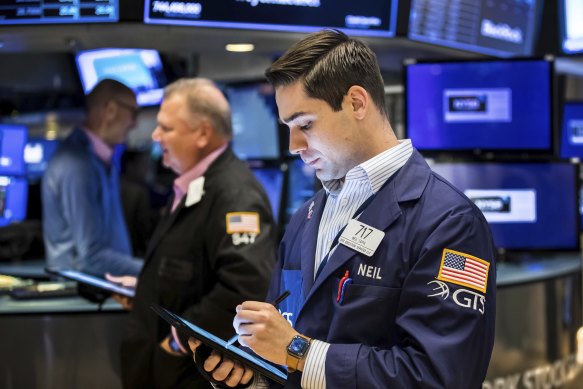ASX opens lower as Wall Street wobbles; miners decline
By Stan Choe and Najma Sambul
The Australian sharemarket opened lower on Thursday as stocks wavered between small gains and losses on Wall Street, having suffered their worst loss since December earlier this week on worries about higher interest rates.
The S&P/ASX200 dropped 12.70 points, or 0.17 per cent, to 7,301.80 at 10:05 am AEDT.

Materials weighed on the market after mining giant Rio Tinto’s profits took a dive in 2022, falling 41 per cent to $US12.4 billion ($18.1 billion) after a bumper result in 2021. The iron ore miner pointed to soaring inflation and softer prices for iron ore, its biggest cash earner, for the result, which fell short of analysts’ forecasts. Its share price was down 2.6 per cent at $122.24 in morning trade.
Rivals BHP and Fortescue were also both down at the open, losing 3.2 and 2.5 per cent, respectively.
Meanwhile, Qantas share price fell by 2.9 per cent even as it announced a $1 billion half-year profit and a share buyback of up to $500 million. Qantas said it raked in $9.9 billion in revenue in the six months to December, following about $7 million in losses during the three years of the pandemic.
Healthcare and communication services were among the winners on the local bourse this morning. Healthcare provider Ramsay Health’s share price jumped 4 per cent as the company lifted dividends after a 22.3 per cent profit increase in the aftermath of the pandemic. Insurer Medibank was also in the green, up 5.2 per cent.
On Wall Street overnight, the S&P 500 was 0.2 per cent lower in late trade after drifting between small gains and losses throughout the day. The Dow Jones fell 0.3 per cent while the Nasdaq composite was up 0.1 per cent.
After leaping at the start of the year, stocks hit a wall in February on worries that inflation may not be cooling as quickly or as smoothly as hoped. That has Wall Street upping its forecasts for how high the Federal Reserve will take interest rates, as well as for how long it will keep them at that level.
High rates can help drive down inflation, but they raise the risk of a recession because they slow the economy. They also hurt investment prices.
Yields in the Treasury market have shot higher this month after several stronger-than-expected reports on the economy forced the recalibration by Wall Street, which had earlier built bets that easing inflation would get the Fed to take it easier on interest rates soon.
The yield on the 10-year Treasury is near its highest level since November. It pulled back a bit from its surge on Tuesday, dipping to 3.91 per cent from 3.95 per cent. That helped take some pressure off stocks on Wednesday.
The two-year yield, which moves more on expectations for the Fed, fell to 4.68 per cent from 4.73 per cent. It’s also been near its highest level since November. If it tops that level, it would be at its highest since 2007.
Traders have in recent weeks reduced bets that the Fed could cut rates later this year. Now they’re in closer alignment with what Fed officials have been telling the market for months, if not preparing for even more.
Investors are penciling in at least two more rate hikes of 0.25 percentage points. They’re even talking about the possibility that the Fed may consider going back to increases of 0.50 points.
The Fed has brought its main overnight rate up to a range of 4.50 per cent to 4.75 per cent, up from virtually zero at the start of last year, in its drive to stamp out high inflation. It’s also said it envisions no cuts to rates this year.
Minutes from the central bank’s last policy meeting showed that nearly all of its policymakers agreed earlier this month to slow the pace of their rate increases to a quarter-point. Its next move on rates will be next month.
Traders see a nearly three-in-four chance that the Fed will raise rates by 0.25 points, according to CME Group. They see a 24 per cent chance of a hike of 0.50 points. A month ago, traders were seeing a roughly 21 per cent chance that the Fed wouldn’t raise rates at all in March.
A relatively lacklustre earnings reporting season for big US companies is winding down, and some of Wednesday’s biggest losers dropped despite reporting better results for the latest quarter than expected. That’s because investors have been putting more emphasis on what companies say about their upcoming results, with worries high about rising costs and high inflation eating into profits.
Most Viewed in Business
Source: Thanks smh.com